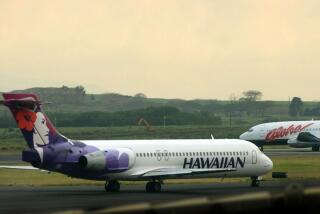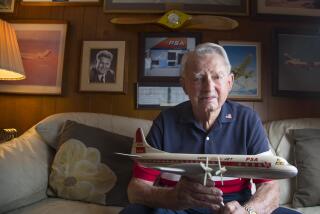PSA Agrees to $400-Million USAir Merger
- Share via
NEW YORK — California air mass transit pioneer Pacific Southwest Airlines fell victim Monday to airline takeover mania, agreeing to be bought for about $400 million by USAir, the nation’s sixth-largest carrier.
The acquisition is the 10th U.S. airline merger announced so far this year and the fourth takeover of a California-based carrier. Last month, American Airlines announced that it was taking over AirCal; in September, Delta Airlines said it would acquire Western Airlines, and in August, Alaska Air announced that it would buy Jet America.
PSA, the leading carrier in the hotly competitive California corridor, is based in San Diego.
In terms of passengers carried, the combination of USAir and 15th-ranked PSA, which must still be approved by shareholders and regulators, would be No. 5 in the country.
Modern Jet Fleet
“We’ve had a long interest in expansion in California,” USAir Group Chairman Edwin I. Colodny said at a news conference Monday morning in Washington. He noted that “one of the beauties” of the proposed consolidation is PSA’s modern fleet of jets. He said that, with the exception of four older DC-9s, all of PSA’s planes are less than six years old. “PSA has the most modern fleet,” he said. “That’s one of the real plusses.”
Analysts applauded the merger.
“This is a good, solid, long-term move for both companies,” said Scott J. Drysdale, airline analyst in the Seattle office of Birr, Wilson, a San Francisco-based broker. “In piecing these systems together, they will have a very large market to build on.”
Under terms of the agreement, USAir will acquire PSA from PS Group, its parent company, for $17 a share. The airline’s stock, traded over the counter, rose sharply Monday, closing at $16 a share, up $4.75.
The takeover announcement also caused PS Group’s stock to rise sharply on the New York Stock Exchange, where it closed at $36.25 a share, up $3.875. USAir Group’s stock dropped to $38.50, down $1.875.
Analysts said the merger will give USAir an important feed of passengers from the West Coast. Most of USAir’s routes are in the Northeast, while PSA flies throughout the West. The two airlines currently both fly out of Tucson, Phoenix, San Diego, Los Angeles and San Francisco.
USAir, which has a hub in Pittsburgh, said Monday that it would extend its route network to Las Vegas, Portland and Seattle from Pittsburgh next year.
Colodny said that USAir, which has 15,000 employees, plans no layoffs of PSA employees. He said that although the dominant name to be used by the merged airline will be USAir, he did not rule out the possibility that the PSA name might continue to be used in some fashion, at least in California.
No. 1 in Corridor
PSA, which began service in 1949 with one leased DC-3, entered the Los Angeles-San Francisco market in 1958. Today it is No. 1 in what has become the most competitive air corridor in the world. About 8 million passengers a year are shuttled up and down the coast on 450 daily flights.
PSA carries 48.7% of these people, far ahead of AirCal, United Airlines and smaller airlines. PSA, which has 4,800 employees, operates nearly 600 flights a day to 29 cities in six Western states and Mexico. The airline has 55 aircraft, of which 20 are British Aerospace 146-200s, said to be the quietest airliner in use. Four more are to be delivered next year and 16 are on option.
Despite PSA’s dominance of the California corridor, the airline has had trouble breaking even in recent years. As a result of intense competition, high fuel prices and some labor troubles, it has not had a profitable year since 1979.
PSA had airline revenues of $635 million last year but lost $649,000. In the first nine months of this year, its airline revenues were $584.9 million and earnings were $2.1 million. Company officials have said recently that PSA could be in the black for the full year.
Management Lauded
USAir Group, for the first nine months of 1986, had a net income of $59,574,000 on revenues of $1.4 billion. Analysts say that USAir is one of the best managed airlines in the nation and that it has been the most consistently profitable airline in the last 10 years.
In the past, however, controversy has swirled about USAir regarding its safety record.
A 1983 Times survey of Federal Aviation Administration records of airline accidents, incidents and violations of regulations during the 1978-1982 period showed that USAir had the worst record of the 11 major carriers surveyed in terms of number of accidents and incidents per number of miles flown.
Improves Dramatically
However, the airline’s safety record had improved dramatically during the five-year period. The accident-and-incident rate decreased from nearly eight per 10 million miles flown in 1979 to about one per 10 million miles in 1982. Its rate of accidents and incidents per 10,000 flights decreased from more than two in 1979 to about 0.5 in 1982.
Comparable figures for the years since 1982 were not available Monday, but David Shipley, a USAir spokesman, said, “We’ve got one of the best safety records in the business.” And a Department of Transportation spokesman said Monday night he knew of no serious safety violations involving either USAir or PSA.
USAir has had five fatal accidents since it began carrying passengers in 1949, the most recent in 1971. It has had no fatal accidents since it has been known as USAir.
But recently, another serious accusation was made against the airline. In September, the Pittsburgh Press reported the results of a survey it made at six of Pittsburgh’s 36 hospitals. It found that emergency room personnel recalled 23 cases of drug overdose by members of flight crews in the last several months. Of these, 19 involved USAir flight personnel. There were additional cases involving ground crews. A grand jury is reportedly looking into the matter. USAir’s Shipley angrily denied the drug stories in a telephone interview Monday and said that only one USAir pilot had been found to be a drug user and that he was immediately grounded.
First to Get Certificate
USAir was the first air carrier certificated after passage of the Civil Aeronautics Act of 1938. Known then as All American Aviation, the airline flew mail over rugged mountain terrain in Pennsylvania and West Virginia with seven pilots and four flight mechanics.
At the time, it was the only bidder for the U.S. Post Office’s experimental contract to provide airmail pickup service for isolated communities without adequate airports. All American’s single-engine monoplanes would swoop down to treetop level and, in a single pass, would drop mail containers and snatch the outgoing mail, which was suspended from flag-topped poles.
It was not until 1949 that the carrier went into the passenger business and, four years later, it took the name Allegheny Airlines. It changed its name to USAir in 1979.
The vast majority of USAir’s operations are currently centered in the Northeast. It serves 78 airports in 31 states, two Canadian provinces and the District of Columbia with its 147 aircraft.
Talks Began in 1978
USAir’s Colodny said in an interview that he initiated contacts with PSA in 1978 about a possible merger but said the discussions were “purely exploratory.” Serious discussions have been under way for the last two weeks.
At a news conference in San Diego on Monday, Paul Barkley, chairman of PSA’s parent firm, said he had been called on the phone by Colodny on the day after last month’s announcement of the American-AirCal merger was made. The final shape of the deal was reportedly hammered out in the last two days.
Barkley said PSA employees would benefit greatly through higher salaries from the merger, which is expected to be completed early next year. Barkley said USAir flight attendants, for example, are paid 14% more than PSA’s; station agents get 18% more; reservations agents, 22% more and pilots, 30% more.
Under union agreements, the employees have first right of refusal to match USAir’s offer for PSA within 60 days. It could not be learned Monday if they had such intentions.
Penny Pagano reported from Washington and Robert E. Dallos from New York. Times staff writer Greg Johnson in San Diego also contributed to this story.
Related story in Business.
More to Read
Inside the business of entertainment
The Wide Shot brings you news, analysis and insights on everything from streaming wars to production — and what it all means for the future.
You may occasionally receive promotional content from the Los Angeles Times.










